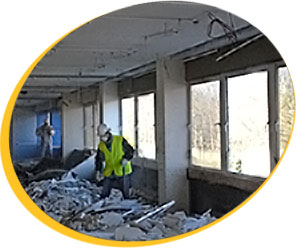Top tips for considering asbestos when doing DIY

If you believe that you may have discovered asbestos in your property, the first rule is not to touch it. Asbestos is a danger in the home after it is disturbed in a manner that creates dust containing asbestos fibres. In lots of cases, the existence of asbestos-containing materials at home is no reason for panic if the material hasn’t been disturbed. If the material is not broken and shows no signs of wear and tear, it can commonly be kept where it is. For instance, internal asbestos ceilings or sheet walls which are in decent condition and have a layer of paint will not pose any risk of health to the occupants, all the while that they do not show any marks of degradation.
Therefore, if asbestos-containing materials reside in your home but are either undamaged or undisturbed, then the best choice is to simply leave them in place.
If you are considering working with or taking away a material containing asbestos when doing DIY, please contemplate the following Top safety tips for considering asbestos when doing DIY:
• If the condition of the material seems good (e.g. undamaged), should you leave it alone?
• Are you aware of the options when confiscating the material containing asbestos, such as painting/sealing or casing with a non-asbestos product?
• Can you fulfil the laws and safety measures when doing DIY with asbestos?
• Would it be a better idea to get in a licensed asbestos expert to remove it?
If you are committed to handling or doing DIY work with asbestos, then it’s key to remember:
• Don’t use high-pressure hoses
• Don’t use compressed air
• Don’t use abrasive cutting or sanding discs
• Don’t use power tools
• Don’t walk on ribbed cement roofs containing asbestos, because you could risk dropping through the roof
• Don’t leave products containing asbestos lying in the garden where they could be fragmented or crumpled
• Make sure the material is tested by an accredited lab if you are uncertain if it holds asbestos
• At all times work with asbestos in properly ventilated spaces
• Guarantee the material is carefully kept wet throughout work to reduce the discharge of fibres and dust
• It is suggested that loose asbestos removal is reserved only for a licensed professional. This is because health risks related to handling this kind of material are much higher than in the case of asbestos which is bound together firmly.
A home owner can legally remove asbestos from their house, but because asbestos carries a health risk in the course of removal, packing, transport and dumping, it is imperative to handle it carefully throughout these projects.
It’s a good idea to look up the OHS website for additional information concerning the safe handling and removal of asbestos within the home.
The ARCA website is a great resource for finding out who can help with asbestos removal, should you need help or advice. The HSE website too is a must-see, before getting involved. Here, you’ll find forums and information to read and discover more before you set about any DIY work.
If you have any concerns with regards to asbestos at work, or even a residential premises, contact our customer services on 01903 297818. or fill in our contact form and we’ll be able to help you further.
